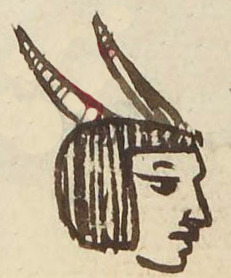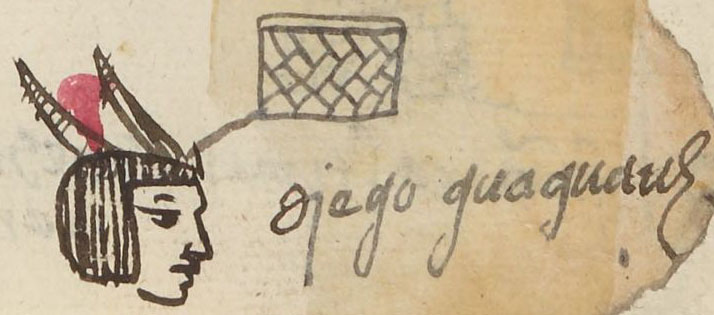Cuacuauh (MH487r)
This personal name glyph, Cuacuauh ("Horned," from cuacuahuitl, horns), is built onto the head of the man who bears the name. The horns lean backward from the top of his head. They have some texturing. His head is shown in profile view, facing the viewer's right. The horns are bent back and very slightly curved. They have short lines that provide some texturing. The addition of the horns onto the head (cuaitl) of the tribute payer could serve as a phonetic complement, underlining that the name started with Cua-.
Stephanie Wood
With the introduction of oxen and cattle that came with colonization, horned animals were much more numerous after the autonomous era. Deer, which were original in the Americas, do also have antlers, so the phenomenon was not entirely new.
Stephanie Wood
diego guaguauh
Diego Cuacuauh
Stephanie Wood
1560
Xitlali Torres and Stephanie Wood
antlers, horns, cuernos, astas

cuacuauh(tli), horns/antlers, https://nahuatl.wired-humanities.org/content/cuacuahuitl-2
cuacuahue, ox, bull, cow, or other horned animal, https://nahuatl.wired-humanities.org/content/cuacuahue
ocuilin cuacuahue, worm with little horns or feelers, https://nahuatl.wired-humanities.org/content/ocuilin-cuacuahue
Él con Cuernos, o Él con Astas
Stephanie Wood
Matrícula de Huexotzinco, folio 487r, World Digital Library, https://www.loc.gov/resource/gdcwdl.wdl_15282/?sp=53&st=image.
This manuscript is hosted by the Library of Congress and the World Digital Library; used here with the Creative Commons, “Attribution-NonCommercial-ShareAlike 3.0 License” (CC-BY-NC-SAq 3.0).






